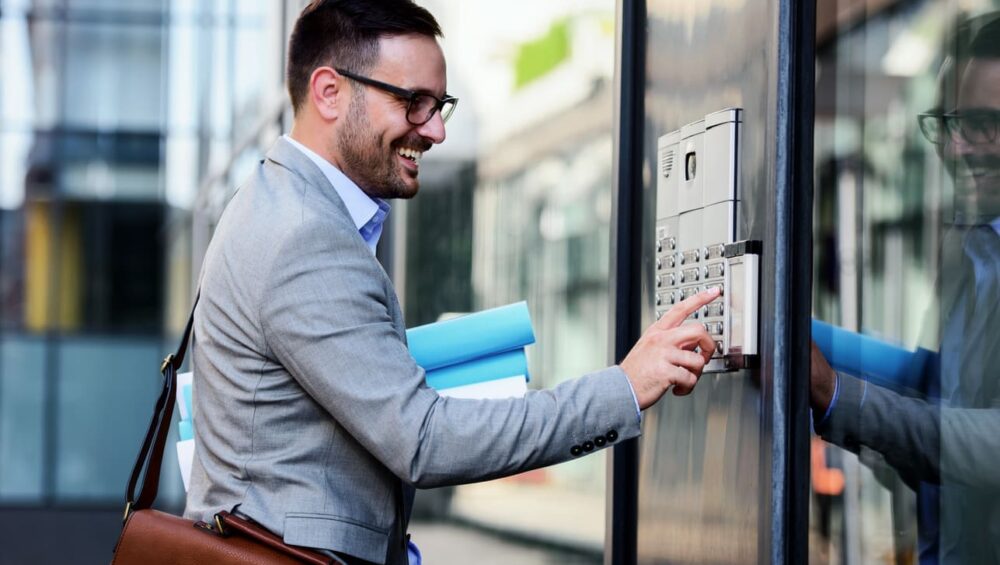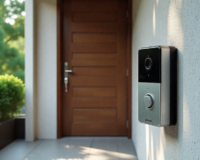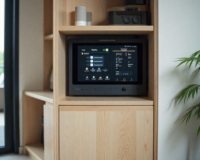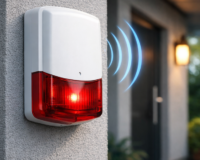Video intercom systems have become essential for security and access control in modern commercial buildings. Various organizations, including businesses, schools, and government offices, depend on these systems for their user-friendliness, accessibility, and versatility.
Their popularity has surged alongside the growth of the smart building market. As people increasingly seek ways to integrate systems and security devices within their properties, they find that these technologies enhance safety and cost-efficiency. The advent of smart cities—urban areas leveraging technology and data to improve quality of life and sustainability—will likely further boost the demand for video intercom systems.
For those new to commercial intercom systems, the wide range of configurations and device types can be overwhelming. Exploring the features and capabilities of this technology can help you narrow down your options and find the best solutions for your business.
What is a Commercial Intercom System?
A commercial or business intercom system is a technology designed to monitor and control access to your property. While similar to residential intercoms, which allow you to communicate with and see a visitor before unlocking the door, commercial intercom systems are typically more complex, advanced, and customizable. This complexity is necessary to accommodate larger spaces with higher visitor traffic.
The most common types of intercom systems for commercial spaces include:
Wireless Intercom Systems
A wireless intercom system usually consists of a doorbell equipped with a microphone and camera that connects to other devices inside the building via Wi-Fi. These systems offer flexibility in installation and placement, as they do not require extensive wiring.
Wired Intercom Systems
Wired intercom systems require the installation of hardware, such as receivers and door releases, throughout the building. While they involve more infrastructure, they typically offer more reliable connectivity and fewer risks of outages.
Audio Intercom Systems
Audio intercom systems enable you to speak with someone at the door from a different location within the building. These systems are often simpler and more cost-effective but provide less security compared to video intercoms.
Video Intercom Systems
Video intercom systems allow you to both see and hear the person requesting access to your building. They offer a higher level of security and convenience, as you can visually verify a visitor’s identity rather than relying solely on voice recognition.
Comparing Different Intercom Options
When evaluating different intercom systems, it’s essential to consider the advantages and limitations of each type:
- Wireless Systems: Offer easy installation and flexibility but may be subject to connectivity issues or Wi-Fi outages.
- Wired Systems: Require more infrastructure and installation effort but provide more reliable and stable connections.
- Audio Systems: Are simpler and less expensive but offer less security since they lack visual verification.
- Video Systems: Provide enhanced security and convenience by allowing you to see and hear visitors, making it easier to verify their identity.
Regardless of whether you choose a wired or wireless system, video intercoms generally offer superior security and convenience compared to audio-only systems. With a video intercom, you can visually confirm a visitor’s identity, adding an extra layer of security to your property.
The Importance of Security in Business
Security is a critical concern for any business, regardless of size or industry. Effective security measures protect not only the physical assets of a company but also the safety and well-being of employees, clients, and visitors. With increasing incidents of theft, vandalism, and unauthorized access, businesses must adopt robust security solutions to mitigate risks.
Introduction to Video Intercom Systems
A video intercom system is an advanced communication system that allows for audio and video interaction between different points within a business premise. Unlike traditional intercoms, video intercoms enable users to see and communicate with visitors before granting access, significantly enhancing security measures. These systems typically consist of several components, including outdoor stations with cameras and indoor monitors.

Advantages of Video Intercom Systems
Video intercom systems have experienced significant growth in recent years, largely due to their ability to complement access control and door entry systems. In 2022, these systems accounted for 41.9% of the market revenue share, demonstrating their importance in modern security solutions. Video intercoms offer a flexible, scalable, and secure way to protect your property and streamline operations.
Enhancing Building Security and Visitor Management
Security remains a top concern for commercial spaces, especially as a 2023 survey revealed that 28% of businesses reported an increase in physical security incidents over the past year. Video intercom systems bolster security by enabling businesses to monitor and manage building visitors more effectively.
At busy company entrances, video intercoms provide constant surveillance or activate upon motion detection or doorbell rings, giving businesses better control and awareness of who is attempting to enter. Some systems also record critical data, such as entry and exit times, creating a comprehensive log that can aid in investigations and provide valuable information to law enforcement in cases of theft or property damage.
Beyond facilitating investigations, video intercoms serve as a deterrent to criminal activities. Positioned prominently, these systems make potential intruders aware that their actions are being monitored, reducing the likelihood of crimes as perpetrators fear immediate detection and police response.

Simplifying Building Access and Communication
In addition to enhancing security, video intercoms simplify access control and internal communication. When someone arrives at the door, the intercom allows you to greet them, verify their identity, and grant or deny access. This capability is especially useful for:
- Admitting customers or clients
- Accepting deliveries
- Welcoming job candidates for interviews
- Greeting vendors
Video intercoms are particularly beneficial for buildings with multiple offices or tenants. Many systems include directories or touchpads, enabling visitors to connect directly with the person they need. This direct line of communication speeds up access control and minimizes disruptions.
Cloud-based video intercom systems further enhance access control by making entry-point monitoring more practical. Whether on-site, at home, or traveling, you can verify visitors’ identities before granting access, ensuring your property remains secure at all times.
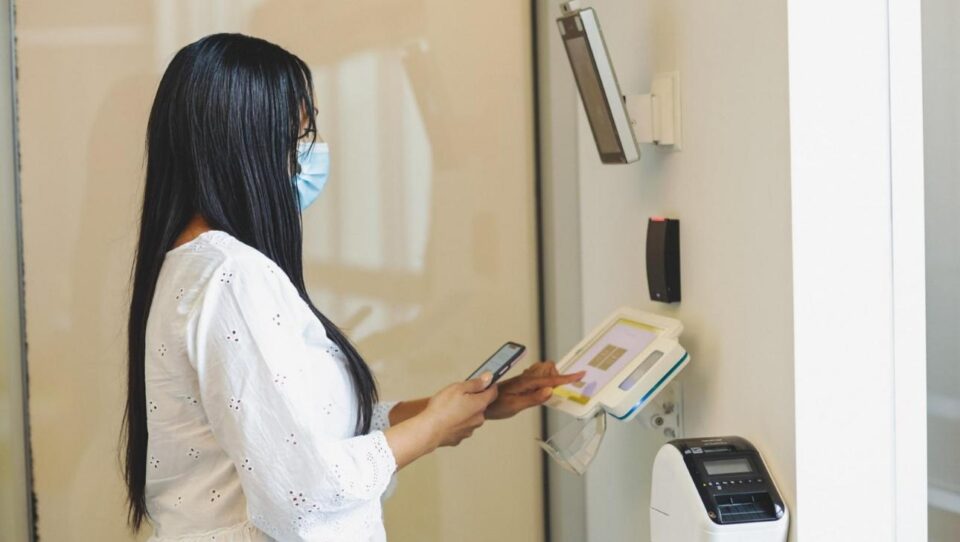
Improving Business Operations
Managing operations when away from the property can be challenging. Important deliveries might be missed, and providing access to contractors or vendors outside of regular hours can be problematic, especially if team members work on a hybrid schedule, leaving the building unstaffed at times.
Modern access systems address these issues by allowing you to set access schedules for different groups, permitting entry through specific doors at designated times. However, video intercoms provide an additional layer of flexibility, enabling instant responses to last-minute access requests from contractors or vendors outside their scheduled hours.
With a video intercom system, you maintain control over building access even when not physically present. You can accept deliveries and instruct drivers on secure drop-off locations or grant entry to contractors and new employees, ensuring smooth operations without needing on-site personnel to handle these tasks.
This flexibility allows you to leave the building as needed without disrupting operations. Employees no longer need to be tethered to their desks awaiting visitors, enhancing productivity and convenience for everyone involved.
Key Features of Business Video Intercom Systems

When selecting a video intercom system for business security, it’s essential to consider key features that will best meet your specific needs. Here are some critical features to look for:
1. High-Resolution Cameras
The quality of the video feed is paramount. High-resolution cameras provide clear, detailed images that are crucial for accurate identification and verification. Look for systems with HD or higher resolution to ensure the best possible video quality.
2. Night Vision Capabilities
Security threats can occur at any time, making night vision an essential feature. Cameras equipped with infrared or other night vision technologies allow for clear video capture in low-light conditions, ensuring 24/7 security coverage.
3. Wide-Angle Lenses
Wide-angle lenses provide a broader field of view, allowing security personnel to monitor a larger area with a single camera. This feature reduces blind spots and enhances overall coverage.
4. Remote Access and Control
Modern video intercom systems often include mobile app integration, allowing users to monitor and control the system remotely. This feature is particularly useful for business owners and security managers who need to oversee security operations while off-site.
5. Integration with Other Security Systems
For comprehensive security, look for intercom systems that can integrate with other security measures, such as CCTV cameras, alarm systems, and access control systems. Integration provides a cohesive security solution that enhances overall effectiveness.
6. Motion Detection and Alerts
Motion detection capabilities can trigger alerts and recording when movement is detected in specific areas. This feature ensures that security personnel are immediately aware of any potential intrusions and can respond promptly.
7. Audio Features
Clear two-way audio communication is crucial for effective interaction between employees and visitors. Look for systems that provide high-quality sound without distortion or interference.
8. Durability and Weatherproofing
Outdoor intercom units should be designed to withstand various weather conditions and potential vandalism. Ensure that the system you choose is robust and durable to maintain functionality in all environments.
Installation Considerations
Proper installation of a video intercom system is critical to its effectiveness. Here are some key considerations to keep in mind:
1. Professional Installation
While DIY installation might be tempting to save costs, professional installation ensures that the system is set up correctly and functions optimally. Professional installers have the expertise to position cameras and intercom units for maximum coverage and effectiveness.
2. Placement of Units
Strategic placement of intercom units is essential for comprehensive security. Outdoor units should be positioned at all entry points, including main entrances, side doors, and loading docks. Indoor units should be placed in security offices, reception areas, and other key locations.
3. Network and Power Requirements
Ensure that your business has the necessary network infrastructure and power supply to support the intercom system. Wired systems may require additional cabling, while wireless systems need a robust Wi-Fi network for reliable operation.
4. User Training
Proper training for all users of the system is essential to ensure efficient operation. Employees should understand how to use the intercom features, including how to verify visitors, communicate effectively, and respond to alerts.
Real-World Applications of Video Intercom Systems
1. Office Buildings
In office buildings, video intercom systems enhance security by managing access to the premises and individual offices. They allow receptionists to verify visitors and delivery personnel before granting access, reducing the risk of unauthorized entry.
2. Retail Stores
For retail stores, video intercom systems can help monitor entry points and stock areas. They enable store managers to oversee security from a central location and communicate with staff in different sections of the store.
3. Warehouses and Industrial Facilities
In warehouses and industrial facilities, video intercom systems are crucial for managing access to secure areas and coordinating communication between different parts of the facility. They enhance the overall safety and security of the premises.
4. Educational Institutions
Schools and universities use video intercom systems to control access to buildings and monitor campus security. These systems help protect students and staff by ensuring that only authorized individuals can enter school grounds.
5. Healthcare Facilities
In healthcare facilities, security is critical to protect patients, staff, and sensitive information. Video intercom systems allow for controlled access to different parts of the facility and enable staff to verify visitors and patients before allowing entry.
How to Choose a Video Intercom System
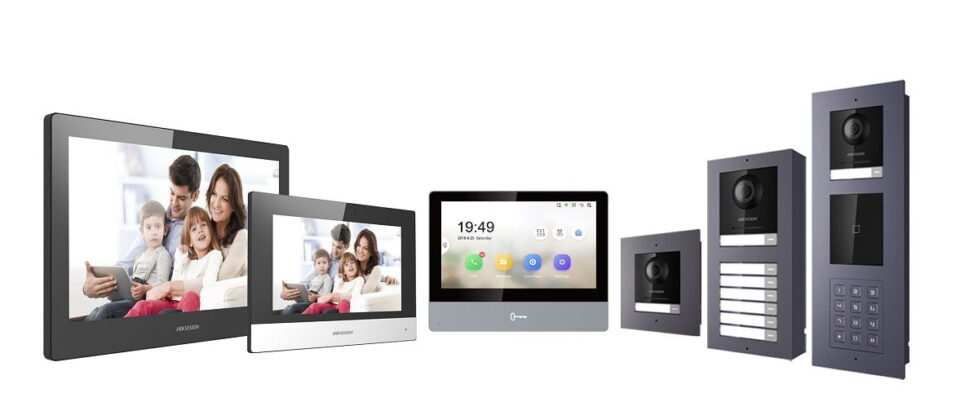
Before investing in a video intercom system, it’s crucial to assess how well it meets your organization’s needs, integrates with your access control system, and fits the design of your property. Here are some key points to consider when comparing your options:
- Installation and Maintenance Requirements: Evaluate the time, cost, and effort involved in installing a new system or upgrading your existing one. Consider the necessary infrastructure and wiring, and ensure that any external hardware can withstand environmental conditions.
- Remote Access: Determine if the system allows you to answer doorbell rings from any location or if it requires you to be at a specific desk or device. Connecting your intercom to a remote access control system enables you to respond to calls and unlock doors from anywhere, providing full control over building access and security.
- Features: Look for a variety of features that offer good value for your investment. At a minimum, ensure the system provides excellent video and audio quality for clear communication with visitors.
- Integrations: Check if each option is compatible with other systems or solutions you use, such as access control, data analytics tools, and security cameras. For example, combining a video intercom with an access control system allows you to remotely unlock doors after verifying the visitor, receive calls through your access control app, and review access events.
- Cost: While many video intercom systems are available on the market, they vary in quality and reliability. Seek a system that fits your budget but also provides the necessary functionalities to interact effectively with visitors and protect your property.
While reading about different video intercom systems is a good starting point, consulting with an expert can provide a more comprehensive understanding of what each system offers. An intercom system can significantly impact the safety, stability, and efficiency of your business, so it’s important to thoroughly explore how it meets your needs before making an investment. The team at DHS is available to discuss your specific requirements and answer any questions you may have.
Future Trends in Video Intercom Systems
As technology continues to advance, video intercom systems are evolving to offer even more sophisticated features and capabilities. Here are some trends to watch for:
1. Artificial Intelligence (AI) and Machine Learning
AI and machine learning are being integrated into video intercom systems to enhance their functionality. These technologies can improve facial recognition, identify suspicious behavior, and provide predictive analytics to enhance security.
2. Enhanced Mobile Integration
As mobile technology continues to advance, video intercom systems will offer even greater integration with smartphones and tablets. This will provide users with more control and flexibility, allowing them to manage security from virtually anywhere.
3. Cloud-Based Solutions
Cloud-based intercom systems offer scalable and flexible solutions for businesses. They provide remote access, storage, and management capabilities, reducing the need for on-site infrastructure and maintenance.
4. Internet of Things (IoT) Integration
IoT integration will enable video intercom systems to connect with a wide range of smart devices, creating a fully interconnected security ecosystem. This integration will allow for more efficient and automated security management.
Conclusion
Video intercom systems are an essential component of modern business security, offering a comprehensive solution that enhances access control, communication, and monitoring. By providing real-time video and audio interaction, these systems enable businesses to verify visitors, manage access, and respond promptly to security threats.
When selecting a video intercom system, it’s crucial to consider key features such as high-resolution cameras, night vision, remote access, and integration with other security systems. Proper installation and strategic placement of intercom units ensure maximum coverage and effectiveness.
As technology continues to evolve, video intercom systems are becoming even more advanced, incorporating AI, cloud-based solutions, and IoT integration to provide robust and flexible security solutions. By investing in a video intercom system, businesses can significantly enhance their security measures, protect their assets, and ensure the safety of employees and visitors.

